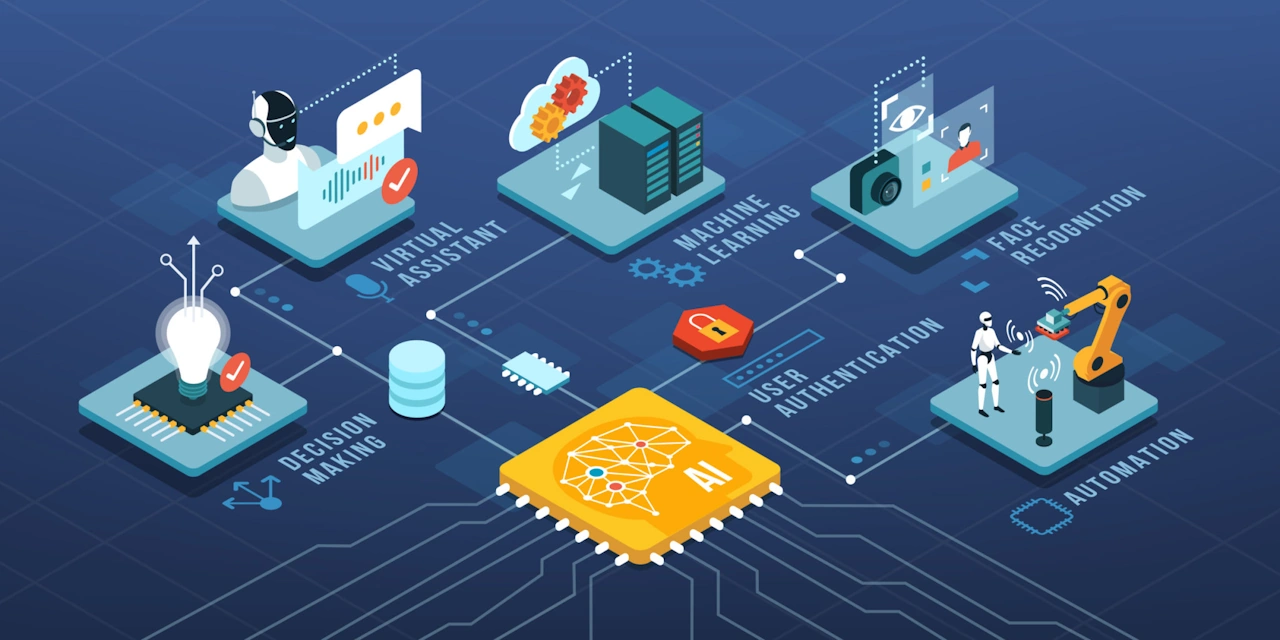
Artificial Intelligence (AI) and Machine Learning (ML) are two terms that are often used interchangeably in the tech world, but they represent different concepts, albeit closely related. To fully grasp their distinctiveness, it’s important to break down both terms and understand how they intersect and diverge.
Understanding the Key Differences:
Artificial Intelligence (AI)
At its core, AI refers to the simulation of human intelligence in machines. These machines are designed to think, learn, and problem-solve in a way that mimics human cognitive processes. AI encompasses a wide range of technologies and applications, from natural language processing (NLP) and robotics to expert systems and computer vision.
AI can be divided into two main categories: narrow AI and general AI. Narrow AI, also known as weak AI, is designed to perform a specific task, such as voice recognition or image classification. These systems are incredibly effective within their limited scope but do not possess the ability to perform tasks outside of their designated function. Examples include virtual assistants like Siri and Alexa, and recommendation algorithms used by streaming services.
General AI, or strong AI, is a theoretical form of AI that possesses the ability to perform any intellectual task that a human can do. This includes understanding natural language, reasoning, problem-solving, and even emotional intelligence. While this remains a goal for many researchers, general AI has not yet been realized and exists mostly in the realm of science fiction.
What is Machine Learning (ML)?
Machine Learning is a subset of AI, but it specifically focuses on the idea that machines can learn from data and improve their performance over time without being explicitly programmed. ML algorithms use statistical methods to analyze patterns in data, learn from them, and make predictions or decisions. Unlike traditional AI, which often involves hard-coded rules, ML systems improve by processing large amounts of data and adjusting their internal models to enhance accuracy and efficiency.
The key difference here is that ML systems “learn” from experience (data), whereas traditional AI relies more on predefined instructions or algorithms to solve problems.
In Conclusion:
While machine learning is a powerful tool within the AI landscape, it is important to understand that AI encompasses a broader vision of creating intelligent machines capable of mimicking human cognitive abilities, including learning, reasoning, and adaptation, not solely relying on data-driven algorithms.
The primary difference between AI and ML lies in their scope and approach. AI is the broader concept of machines being able to carry out tasks in a way that we would consider “smart.” ML is a specific method used to achieve that smart behavior.
In essence, all ML is AI, but not all AI is ML. AI can include expert systems, where rules are manually coded, while ML relies on learning patterns from data. Furthermore, ML algorithms require large amounts of data and computational power, whereas some AI systems can function with simpler rule-based logic.

İstanbul da kaçak su tespiti
November 8, 2024İstanbul da kaçak su tespiti Ümraniye su kaçağı tespiti: Ümraniye’de su kaçaklarına son veren uzman ekip. https://dglonet.com/ustaelektrikci
vivod iz zapoya chelyabinsk_iboa
November 8, 2024вывод из запоя на дому в челябинске [url=https://www.vyvod-iz-zapoya-chelyabinsk11.ru]вывод из запоя на дому в челябинске[/url] .
women nude pics
November 9, 2024People find it much more appealing to see dressed bodies than to be completely covered up.
And one of the things that appeals is the experience of risk, such as when a woman plays intercourse and feels embarrassed or exposed while she is
nude. When both factions are buff, it increases the connection of gender.
When their spouse is defenseless, dominance tends to appeal to
some guys specifically. And let’s not forget about the skinny porn: they genuinely go all out when it
comes to showing off anything, focusing on penetration, and on privates. https://wiki.nw2online.com/api.php?action=http://legendawiw.ru/forum/index.php?action=profile;u=412656
earllk60
November 11, 2024Hd dojki download porn video mp4 view online porn with
http://trades.androidsexysongjithu.a4ktube.com/?destinee-ximena
disney simpson porn sex hump porn horny huge boner porn collection websites porn stars who have stds amatur porn long dick
pujcka 100 000 bez dolozeni prijmu v cesku
November 14, 2024Přijetí hypoteční platby může být obtížné pokud nemáte rádi čekání v dlouhých řadách ,
vyplnění vážný formuláře , a odmítnutí úvěru na základě vašeho úvěrového skóre .
Přijímání hypoteční platby může být problematické, pokud nemáte rádi čekání
v dlouhých řadách , podávání extrémních formulářů , a odmítnutí úvěru na základě vašeho úvěrového skóre .
Přijímání hypoteční platby může být problematické
, pokud nemáte rádi čekání v dlouhých řadách , vyplnění extrémních formulářů a odmítnutí úvěrových
rozhodnutí založených na úvěrových skóre .
Nyní můžete svou hypotéku zaplatit rychle a efektivně
v České republice. https://groups.google.com/g/sheasjkdcdjksaksda/c/J0kT4gGKNgY
tlover tonet
November 24, 2024Simply wanna remark on few general things, The website style and design is perfect, the subject matter is rattling wonderful : D.
vorbelutrioperbir
December 19, 2024This blog is definitely rather handy since I’m at the moment creating an internet floral website – although I am only starting out therefore it’s really fairly small, nothing like this site. Can link to a few of the posts here as they are quite. Thanks much. Zoey Olsen
drover sointeru
December 28, 2024I really appreciate this post. I¦ve been looking all over for this! Thank goodness I found it on Bing. You have made my day! Thanks again
JorgeCat
January 22, 2025Mexican Easy Pharm: mexican pharmaceuticals online – Mexican Easy Pharm